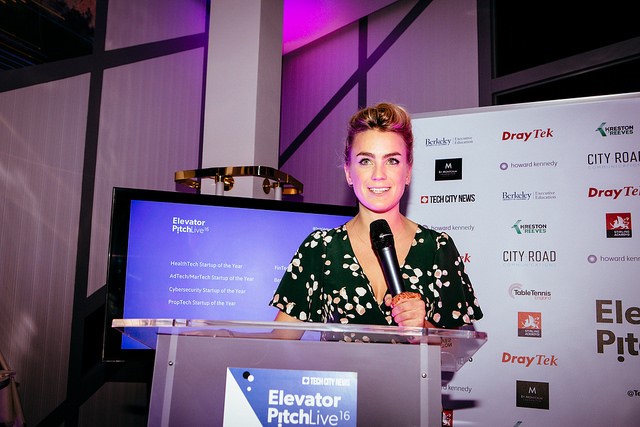Pitch is the abbreviation for “sales pitch” or sale argument.
Pitching has its origins in the term “elevator pitch” o “elevator speech”, when an entrepeneur happened to meet a feasible investor or a CEO in an elevator and tried to convince him/her of his/her idea or business project. Therefore, the discourse had to be quick and effective, since the entrepreneur had only between 40 seconds and a minute.
The baseball comparison has also been used. In this game, a player (pitcher) throws a ball (the idea, product or project), which must be caught on the fly by another player (customer) by using a glove (intest, curiosity…).

[CC-BY 2.0], Flickr https://flic.kr/p/PFrsKt
At present, this term is extensively used in business and entrepreneurship schools worldwide. It is a technique of oral or visual presentation used in the selection of entrepreneurial projects or in the direct selling of your ideas or products. It mainly involves creating curiosity about your product or your idea. The most frequently used format is the presentation (normally developed by using multimedia. It usually lasts around 20 minutes).
In the infographic below, you will find a summary of the most important aspects about the “elevator pitch” or pitching technique.
Source: https://es.pinterest.com/pin/266767977911398973/
Source: https://www.pinterest.com/pin/266767977911398979/
As an entrepreneur, it is highly probable that you have to present your products or your entrepreneurial project by using the pitching tecnique. The most important aspects to be taken into account when using the pitching tecnique to present your idea or your product are the following:
Show yourself confident, calm and smiling. You have to be convincing and assertive while you are speaking and you have also to communicate spontaneity and interpersonal intelligence. This will build trust with your listeners.
The presentation must be short in order to create expectation and curiosity. Normally, it should not take more than 20-30 minutes, having also into account that you have to leave some time for questions. Remember that, as a general rule, the shorter the better, that is why we do not have to try to explain everything. It may be also useful practising your pitch with different time limits so that you may switch it to situations with very little time, around 5 or 10 minutes.
Knowing the audience that is going to attend your presentation will give you a certain advantage and will allow you to include even more attractive details in your pitch.
Finding an attractive creative and easy to remember title will make listeners be attentive from the very first moment, so they will remember your presentation much better.
Introduce your pitch trying to create an emotional bond, in the same way that you would do it in a storytelling, although shortly and using very simple ideas. The best memories are the emotional ones. Stories and anecdotes are much better remembered than data and statistics.
Always go from simple to complex, from global to detailed.
If you think that there are some lacks in the market related to the product that you are offering, point them out and indicate how your product could cover those lacks.
Analyze and study the market you are going to aim at. There is a large amount of tools available on web 2.0 services for that purpose.
Also analyze your product´s or your idea´s feasible weaknesses and try to foresee them by correcting them during the presentation if necessary.
Show a realistic offer of your product, but make it clear that it is flexible enough to be adapted to the customer´s real needs at some point.
Make clear that your product is different from those of the competition but without talking about the competition. Explain its advantages, your achievements and, if possible, point out some positive experiences that you have had with your customers.
When talking about your strengths and weaknesses, it is better to be honest rather than to say sentences such as “my products are the best”, “I´m the best expert”, etc. Do not lie about your product. Otherwise, it can really affect the rest of your presentation negatively. Highlight your work team´s strengths if you have one. This builds trust with customers.
It is also very important not to just read the presentation, but also to comment on the main aspects. If you just read the presentation you will give the impression that you do not master the topic you are talking about.
Do not try to show all your ideas in detail in the presentation because it is not possible. Use images and comment on their meaning. Explain the most general ideas instead of explaing the details. If you use too much text in your presentations you will just cause your audience to lose track of it.
Always pay attention to the non-verbal communication that you are going to use throughout your presentation: your gestures, eye contact with the audience, your body language, etc.
Finish your presentation by indicating to the audience that your products´possibilities are much better and that they have only seen a part of them.
In the infographic below you will find a summary about how to set out a pitch or presentation of this type in only 10 slides.
Source: https://www.pinterest.com/pin/266767977911398953/
In the following video you will see one of the most famous pitches that has been probably made: the iPhone presentation by Steve Jobs in 2007.















